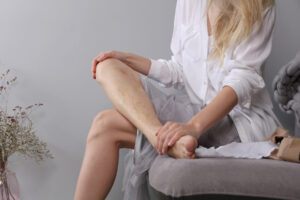Varicose and Spider Veins
 One of the most common concerns of aging women is the appearance of varicose veins on their legs. Varicose veins and spider veins are swollen, twisted veins that are mostly found on the legs and appear more in women because pregnancy tends to increase the risk of having them. Additional factors are older age and obesity. Both types of veins are usually painless, don’t cause health problems, and can be treated for cosmetic purposes. Some people report experiencing aching pain and discomfort, while varicose veins sometimes lead to more serious problems.
One of the most common concerns of aging women is the appearance of varicose veins on their legs. Varicose veins and spider veins are swollen, twisted veins that are mostly found on the legs and appear more in women because pregnancy tends to increase the risk of having them. Additional factors are older age and obesity. Both types of veins are usually painless, don’t cause health problems, and can be treated for cosmetic purposes. Some people report experiencing aching pain and discomfort, while varicose veins sometimes lead to more serious problems.
What is the difference?
Varicose veins are red, blue, or skin colored and seem to have a rope-like texture, while they also tend to cause the skin to bulge out. They are often on the thighs and calves, as well as the inside of the leg near the ankles and feet. During pregnancy they can also happen in the lower pelvic area and the buttocks.
Spider veins are smaller than varicose veins, and predominantly red. They can be seen under the skin, but they do not make the skin bulge. They can from tree-like designs or look like spider webs (hence their name). Most commonly, they are seen on the legs and face.
Symptoms
Other than simply appearing under your skin, you may experience an achy feeling on your legs, muscle cramping, or swelling on your lower legs. Another sign may be worsened pain after either sitting or standing for an extended period of time. Itching or skin discoloration around veins may also be indicative of varicose veins forming.
Risk Factors
- Age: the older you get, the more chances there are of getting varicose veins. Wear and tear on the valves of your veins is normal with age, and eventually the blood may collect back into your veins instead of flowing up to your heart.
- Sex: as stated above, women are more likely to develop varicose veins. Hormonal changes may play a role, as they tend to relax vein walls. Additionally, hormone treatments increase the risk of varicose veins.
- Pregnancy, family history, and obesity are other risk factors you should take into consideration if you are worried about varicose veins in older age.
Prevention
Though you cannot completely prevent varicose or spider veins, as they have to do with normal wear and tear of your vein valves and strength of muscles, there are some ways to minimize the risk of getting them or avoid getting more. Improving your circulation and muscle tone through exercising, watching your weight, lowering salt intake, avoiding high heels, elevating your legs, and avoiding sitting down or standing up for a long time are all ways which may help reduce the risk of varicose veins.
